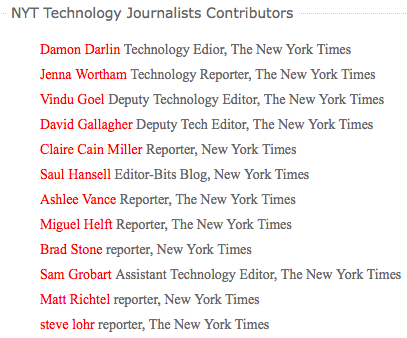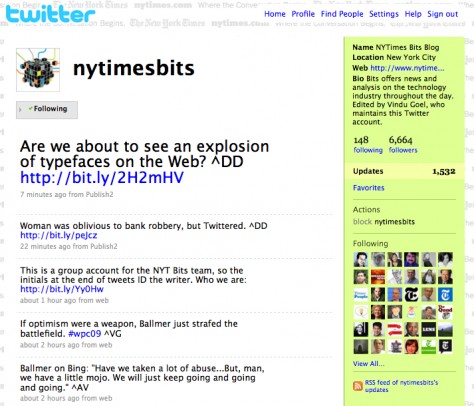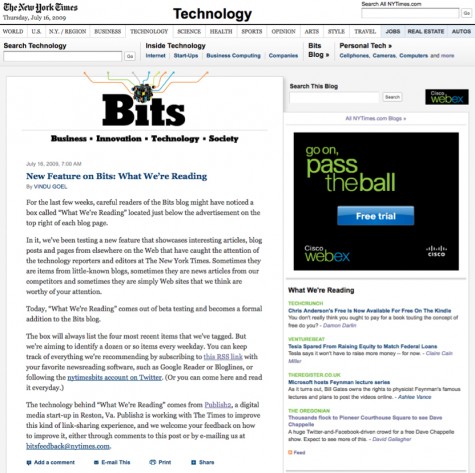Best Practices for Journalists Curating the Web: New York Times Bits Blog "What We're Reading"
The New York Times technology blog, Bits, which features original online reporting by all of the NYT technology journalists, has formally launched a new feature called “What We’re Reading.” This feature (powered by Publish2) illustrates a number of important best practices for how journalists and news orgs can create significant value for readers by curating the web. I’ve got six of them for you.
But first, here’s what the feature looks like, in the blog’s right sidebar, under the ad at the top (click for larger image):
And here are the six best practices:
1. Make it a collaborative effort.
With all that journalists are being asked to do on the web, it’s not ideal from a workflow perspective for one reporter or editor to carry the burden of curating the web. Bit’s “What We’re Reading,” like the blog, is a collaborative effort of NYT technology journalists as a group:

Here are all of the NYT technology journalists contributing to What We’re Reading (via a Publish2 newsgroup, designed to enable this type of collaboration):

The Bits blog is “aiming to identify a dozen or so items every weekday,” which is much easier with a dozen contributors than with one.
2. Comment to explain why the link is worth clicking.
Next to search, the greatest driver of traffic on the web is social recommendations, i.e. person-to-person recommendations. TechCrunch, for example, now gets nearly 10% of its traffic from Twitter, which is simply people recommending links to each other.
When people recommend something to each other, they typically say something about what they are recommending. This distinguishes personal recommendations from machine recommendations — algorithms can automatically pull the lede, but they can’t tell you what they think or highlight what’s interesting about a story.
NYT tech journalists make the What We’re Reading feature much more valuable — and differentiated from headlines produced by algorithms — by adding a comment to every link:

As New York Times deputy technology editor Vindu Goel observes, “readers should know why you are recommending a certain item so they can decide whether it’s worth their time to check out.”
You can think of it as a mini-blog, since blogging grew out of sharing links along with what you think about what you’re linking to.
3. Attribute links to individual journalists.
This best practice follows from commenting on each link. People click on links in Twitter, in Facebook, or in email based on WHO recommended it to them. Blogs on news sites are a great way for journalists to build up their personal brands — sharing what they’re reading is an extension of that.

4. Share links on Twitter.
Speaking of Twitter, NYT Bits journalists also share what they’re reading with Bits’ 6,700 followers on Twitter (automatically through the Publish2 newsgroup). Sharing links was Bits’ first foray beyond what most news orgs do with a Twitter account, i.e. auto-post their own headlines, and it’s a significant enhancement to the value of their Twitter feed.

One of the easiest ways for a news org to enhance its Twitter feed — and be more like individuals with lots of Twitter followers — is to share links to interesting things. It’s a fundamentally social practice.
Following best practice #2 each link shared on Twitter has the journalist’s comment (rather than the link’s title), and following best practice #3, each has the journalist’s initials after the comment, e.g. ^SH is Saul Hansell (again, done automatically via Publish2 newsgroup).
5. Integrate into existing workflow.
The What We’re Reading feature is well named, both as a simple description for readers and as a literal description of the workflow behind it. As Vindu observed: “As journalists, we’re constantly looking at news coverage, blogs and Web sites. Why not share the most interesting stuff we find with our readers?”
And the time required?
Vindu: “Less than a minute, which was really important to us. Publish2 worked with us to configure the selection tool to automatically include a lot of the key information, such as our Twitter feed. So when I find an item I want to share, I click on a button in my Web browser, edit the headline of the linked article if necessary (sometimes they are really long or incomplete), add a public comment and hit “Save” to send it out to the world.”
The link is automatically added to What We’re Reading via Publish2. No need to log in to a CMS or even leave the page that they’re reading.
Previously, interesting items that NYT technology journalists came across that didn’t make it into a NYT print article or a Bits blog post ended up on the “cutting room floor.” The only change to workflow is they are now sharing those interesting items with their readers — on the blog and on Twitter in one step.
6. Complement original reporting.
What We’re Reading, positioned high in the right sidebar, serves as a perfect complement to the original reporting in the main blog on the left. Curating the web, like blogging, should be a fundamental skill of every journalist who wants to create value in a web media world.
Vindu: “There’s is a lot of great information out there on the Web that isn’t produced by The Times. Our overarching goal as a news institution is to inform our readers. Often that’s with outside content. So What We’re Reading is part of a broader effort by The Times to feature strong third-party content on our site. For example, we have modules on our Technology home page, www.nytimes.com/technology, that show stories from respected tech blogs such as ReadWriteWeb and GigaOM.”
Lastly: Should Bits fear “sending readers away”? No more than Google or Drudge Report should. Do a great job sending readers to interesting content on the web, and they’ll keep coming back for more.
